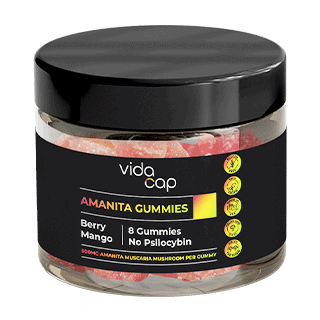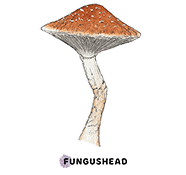What are the differences between different psilocybin-containing mushroom species? We’ve compared the identification, potency, and cultivation conditions of some of the most popular magic mushroom strains to see which might be best for you.

Want to experience the ‘magic’ of the Amanita muscaria mushroom? Iconic U.S. brand VidaCap has just launched a new range of 500mg Amanita gummies that soothe the mind and harmonize both body and spirit. Try them today and get 25% OFF all orders with WayofLeaf’s exclusive coupon code: AMANITAWOL
What Magic Mushroom Strains Are the Best?
Magic mushrooms are species of mushroom that contain the psychoactive compound psilocybin. Psilocybin acts on 5HT2A receptors in the brain and causes mind-altering effects.

Common effects of ingesting psilocybin mushrooms include:
- Euphoria
- Visual hallucinations
- Altered perceptions of time and space
- Synaesthesia (senses merging)
- Decreased sense of self
There are over 200 different types of magic mushrooms. Each species of magic mushrooms has varying concentrations of psilocybin and psilocin and baeocystin, which are also psychoactive compounds. The different amounts of each compound mean the overall effects can differ between each mushroom species.
People who prefer more intense trips may want to take more potent magic mushrooms.
People may have different preferences between magic mushroom species based on their psilocybin content. For example, people who prefer more intense trips may want to take more potent magic mushrooms.
Different species of magic mushrooms also require various conditions to grow. People growing their own might have a favorite type of magic mushrooms based on ease of cultivation.
We’ve provided a comparison between some of the most popular magic mushroom strains so you can decide which shrooms might be best for you.
Psilocybe Hoogshagenii
Psilocybe hoogshagenii is known for its spiritual use among indigenous Mexican peoples. They are also known as Psilocybe Semperviva, with Semperviva meaning “long-life” as these mushrooms have prolonged survival and are resistant to contaminants.
What do they look like?
P. hoogshagenii caps are a red-brown to orange-brown color and are roughly between 1 – 2.5cm in diameter. The stems are approximately 5 – 9cm long and 1 – 3mm thick and a white-brownish color and red towards the base
P.hoogshageniihas gills (papery ribs underneath the cap) that are purple-black in fully matured mushrooms.
Where are they found?
P. hoogshagenii grows natively in Puebla, Oaxaca, and Chiapas in Mexico and regions in Columbia, Brazil, and Argentina.
They tend to grow well in muddy clay soils in subtropical coffee plantations.
How does it feel to consume them?
The mushrooms’ psychoactive potency has been rated “moderately active,” and the psilocybin content reported to be approximately 0.6 milligrams per gram of dried mushroom.
P. hoogshagenii is used today in spiritual ceremonies by indigenous peoples of Mexico, suggesting they produce a notable entheogenic effect.
P. hoogshagenii has been used traditionally by the Chinatec-speaking people from Oaxaca, Mexico, to diagnose and predict the course of different diseases. The Chinatec refer to these mushrooms as ‘atkat’ or ‘judge’ as they consider the species extremely wise.
Psilocybe Azurescens
P. azurescens grow naturally in woody areas around North America. Their high percentage of psilocybin makes them one of the most potent psychedelic mushrooms known.
What do they look like?
P. azurescens have dark caramel-colored caps that start as convex and become later flattened. The caps are around 3 – 10cm in diameter and have a smooth surface and a noticeable broad umbo (raised area in the center).
The stem can be between 9 – 20cm long and white but turns grey/brown as the mushroom matures. The base of the stem often has white tufts.
Where are they found?
P. azurescens grow best in sandy soils rich in debris and deciduous and gregarious wood-chips.
P. azurescens were initially discovered near the Columbia River near Oregon in the United States. They also grow natively in Washington, California, America, and British Columbia, Canada.
How does it feel to consume them?
P. azurescens are one of the most potent known mushrooms in the world. The psilocybin content has been found to be up to 1.8 milligrams per gram of dried mushroom.
Reports have described the experience as incredibly intense with strong visual hallucinations and physical sensations, including feeling energized. The strength of the mushrooms can make them cognitively disorientating.
Psilocybe Bohemica
P. bohemica is a mushroom native to Europe. Up until recently, it was split into three different species: P.bohemica, P. arcana, and P. moravica. However, scientists have now shown that, genetically, all the mushrooms are of the same species but are highly variable.
What do they look like?
P. bohemica has a broadly convex cap that is smooth, an orange-brown color, and between 2 – 4cm. The stem is between 4.5 – 8cm and 2 – 10mm in diameter, a white color, and covered in a silky gloss.
P. bohemica has subdecurrent gills (run down the stem) that are dark brown with purple tints.
Where are they found?
P. bohemica is found frequently on decaying wood from deciduous and coniferous trees.
The mushrooms grow best in moist areas with sun exposure and are found natively throughout North-Eastern Europe.
How does it feel to consume them?
P. bohemica has a wide range of psilocybin concentrations, ranging between 0.11 to 1.34 mg psilocybin per 1 gram of dried mushroom. This means the potency and strength of effects between different mushrooms of the same species are highly variable.
Psilocybe Semilanceata
People commonly refer to P. semilanceatamushrooms as liberty caps due to their distinctive spear-shaped cap (semilanceata meaning spear in Latin). They are found naturally in multiple European countries and tend to bloom in Autumn time, around October.

What do they look like?
P. semilanceata has conical, brown caps ranging between 0.5 to 2cm with a distinctive “nipple-like” umbo. The stems are narrow, roughly 0.4 – 1 cm thick. Often, the stems are enlarged at the base.
The gills of the mushrooms are crowded together and dark grey in mature mushrooms.
Where are they found?
P. semilanceata favor growth in areas with rich soil, typically in grasslands such as meadows and pastures.
They are the most widely distributed psychoactive mushroom known to date and are likely native Europe but can be found growing in North America, Canada, and New Zealand.
How does it feel to consume them?
P. semilanceata has a wide range of psilocybin concentrations, ranging between 0.2 to 2 mg psilocybin per 1 gram of dried mushroom. The range of potency means the strength of effects between different mushrooms of this species is highly variable.
Reports suggest deep insights, visual and spatial distortion, and depersonalization (disassociation with personal reality) are common effects of P. semilanceata.
P. semilanceata has a high ratio of psilocybin compared to psilocin, which is a readily available psychoactive compound psilocybin is broken down into. This means the effects of P. semilanceata tend to come on slower and last longer than other mushrooms, as more psilocybin needs to be broken down.
It is essential that anybody foraging these mushrooms is aware of and can tell the difference between P. semilanceata and toxic look-alike mushrooms, which can be fatal if ingested.
Psilocybe Cyanescens
P. cyanescens mushrooms are also called wavy caps due to their appearance.
These mushrooms are highly prolific, and the number of places in which they can be found is rapidly expanding. Their increasing abundance is likely because they grow well on wood chips, and commercial distribution of wood chips across the globe has spread their mycelium.
What do they look like?
P. cyanescens have a brown cap, between 1.5-5cm, which has a “wavy” shape and turns to a slight-yellow color when dried.
The stems are between 4 – 9cm long, slightly wider at the top, and covered in silver fibers.
Whenever the mushroom’s stems or gills are touched or damaged, they readily turn a blue color.
Where are they found?
P. cyanescens grow on wood chips and mulched plant beds in urban areas.
They naturally grow in the Pacific Northwest in the United States, Western, and Central Europe, Iran, and New Zealand.
How does it feel to consume them?
P. cyanescens contain around 0.85 mg of psilocybin per 1 g of dried mushroom, making them moderately potent.
Reports suggest that P. cyanescens produces intense, vibrant visual hallucinations and is similar in experience to that of P. cubensis.

Now that you know what the best magic mushroom species are, why not buy the best magic mushroom spores online? Fungushead sells syringes containing hundreds of thousands of premium-quality magic mushroom spores for you to study at home. Choose from popular strains, such as Penis Envy, Golden Teacher, B+Cubensis, and more! FungusHead ships to 47 states and accepts Crypto, Zelle, Cashapp, and Venmo payments. So, don’t miss out; get your favorite strain today!
Summary of the Best Magic Mushrooms
Each different magic mushroom species has its unique concentration of psychoactive compounds, leading to distinctive effects. A more in-depth comparison chart between the varying concentrations of psilocybin, psilocin, and baeocystin is in the article sources below.
A person’s mindset and environment can have tremendous impacts on the outcome of their trip.
Although the different species contribute to differing effects of magic mushrooms, the set and setting is the most important factor. A person’s mindset and environment can have tremendous impacts on the outcome of their trip. Therefore, taking necessary harm-reduction steps to ensure the best set and setting is essential for anybody wanting to take magic mushrooms.

If you truly want to learn more about different mushroom strains, check out the full Fungushead spore range. The Psilocybe cubensis species is well represented, with the brand’s collection including golden teacher, penis envy and B+ spores. The more you learn about these magical mushrooms, the more you’ll realize how remarkable they are. Fungushead accepts various payment methods, including cryptocurrency, and legally ships its spores to 47 American states.













